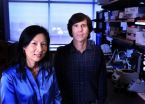(Press-News.org) MADISON — Most people cross borders such as doorways or state lines without thinking much about it. Yet not all borders are places of limbo intended only for crossing. Some borders, like those between two materials that are brought together, are dynamic places where special things can happen.
For an electron moving from one material toward the other, this space is where it can join other electrons, which together can create current, magnetism or even light.
A multi-institutional team has made fundamental discoveries at the border regions, called interfaces, between oxide materials. Led by University of Wisconsin-Madison materials science and engineering professor Chang-Beom Eom, the team has discovered how to manipulate electrons oxide interfaces by inserting a single layer of atoms. The researchers also have discovered unusual electron behaviors at these engineered interfaces.
Their work, which is sponsored by the National Science Foundation, will be published Feb. 18 in the journal Science and could allow researchers to further study and develop interfaces with a wide array of properties.
Eom's team blends theorists and experimentalists, including UW-Madison physics professor Mark Rzchowski and collaborators at the University of Nebraska-Lincoln, University of Michigan, Argonne National Laboratory and Brookhaven National Laboratory.
The researchers used two pieces of precisely grown strontium titanate, which is a type of oxide, or compound with oxygen as a fundamental element. Between the pieces, the researchers inserted a one-atom-thick layer of one of five rare-earth elements, which are important components in the electronics industry.
The team found that the rare-earth element layer creates an electron gas that has some interesting characteristics. The gas actually behaves more like an electron "liquid," since the electrons move more in tandem, or in correlation, than a gas normally does.
"If you take two materials, each has different characteristics, and if you put them together, at their interface you may find something unexpected," Eom says.
This research is the first demonstration of strong correlation among electrons at an oxide interface. The electron layer displayed distinct characteristics depending on the particular rare-earth element the team used. Materials with larger ionic radii, such as lanthanum, neodymium and praseodymium, are conducting, whereas materials with smaller radii, including samarium and yttrium, are insulating.
The insulating elements form an electron gas that can be compared to a thick liquid, somewhat like honey. The higher viscosity (basically, thickness) means the electrons can't move around as freely, making them more insulating. Conversely, the conducting elements form a gas that is a "liquid" more like gasoline; the viscosity is lower, so the electrons can move more freely and are better conductors.
Prior to this research, scientists knew extra electrons could reside at interfaces, but they didn't realize the complexity of how the electrons then behaved together at those interfaces.
The discovery of liquid-like behavior in the electron layer could open up an entire field of interfacial engineering for other scientists to explore, as well as new applications that take advantage of electron interactions. Since Eom and his colleagues developed an understanding of the basic physics behind these behaviors, their work could be expanded to create not only conductive or insulating interfaces, but also magnetic or optical ones.
Though scientists previously have looked at semiconductor interfaces, Eom's team is the first to specifically address those that use oxide interfaces to control conducting states with a single atomic layer. Oxides make up a class of materials including millions of compounds, and each has its own unique set of properties. The ability to manipulate various oxide interfaces could give rise to new generations of materials, electronics and other devices.
"This advancement could make a broad impact in fields even beyond physics, materials or chemistry," Eom says. "People can use the idea that an interface made from a single atomic layer of different ions can be used to create all kinds of properties."
###
Sandra Knisely, 608-346-1463, knisely@wisc.edu
Engineering atomic interfaces for new electronics
2011-02-18
ELSE PRESS RELEASES FROM THIS DATE:
Identification of glaucoma gene brightens view for future therapies
2011-02-18
Glaucoma – a leading cause of vision loss and blindness worldwide – runs in families. A team of investigators from Vanderbilt University and the University of Florida has identified a new candidate gene for the most common form of the eye disorder, primary open angle glaucoma (POAG).
The findings, reported Feb. 17 in the open-access journal PLoS Genetics, offer novel insights into glaucoma pathology and could lead to targeted treatment strategies.
Elevated pressure inside the eye is a strong risk factor for POAG. Pressure increases because of increased resistance to the ...
Checklist cuts lethal ventilator-associated lung infections
2011-02-18
Cases of ventilator-associated pneumonia — the most lethal and among the most common of all hospital-associated infections — dropped by more than 70 percent in Michigan hospitals where medical staff used a simple checklist designed by Johns Hopkins researchers. Such pneumonias kill an estimated 36,000 Americans each year.
The findings, published online in the journal Infection Control and Hospital Epidemiology, show how a relatively simple series of steps, coupled with an education program and a culture that promotes patient safety, can save tens of thousands of lives ...
New Pitt projects will test brain computer interfaces for people with spinal cord injury
2011-02-18
PITTSBURGH, Feb. 17 – Researchers at the University of Pittsburgh have been awarded funding for two projects that will place brain-computer interfaces (BCI) in patients with spinal cord injuries to test if it is possible for them to control external devices, such as a computer cursor or a prosthetic limb, with their thoughts.
The projects build upon ongoing research conducted in epilepsy patients who had the interfaces temporarily placed on their brains and were able to move cursors and play computer games, as well as in monkeys that through interfaces guided a robotic ...
A genetic mutation allows Hudson River fish to adapt to PCBs
2011-02-18
NEW YORK, Feb. 17, 2011 – A research group led by a New York University School of Medicine scientist discovered a genetic variant that allows a fish in the Hudson River to live in waters heavily polluted by PCBs. In a study published in the February 18, 2011, online issue of Science, they report that a population of Hudson River fish apparently evolved rapidly in response to the toxic chemicals, which were first introduced in 1929, and were banned fifty years later. PCBs, or polychlorinated biphenyls, were used in hundreds of industrial and commercial applications, especially ...
Turning forests into fuel: New report outlines promise and limits of biomass energy in the Northeast
2011-02-18
(Millbrook, N.Y. – Feb 17, 2011) Forest biomass could replace as much as one quarter of the liquid fossil fuel now being used for industrial and commercial heating in the Northeastern United States. That's according to a new report released today by the Cary Institute of Ecosystem Studies.
But the report also has sharp caveats: The potential for forest biomass varies widely within the region, and forest resources must be carefully managed to protect the other important services and goods they provide. Under the right circumstances, however, the report found that forest ...
Unraveling how prion proteins move alon axons in the brain
2011-02-18
Researchers at the University of California, San Diego School of Medicine have identified the motors that move non-infectious prion proteins (PrPC) – found within many mammalian cells – up and down long, neuronal transport pathways. Identifying normal movement mechanisms of PrPC may help researchers understand the spread of infectious prions within and between neurons to reach the brain, and aid in development of therapies to halt the transport.
Their study is published in the February 18 edition of the journal Cell.
The small prion protein is found in the cell membrane ...
Pollution triggers genetic resistance mechanism in a coastal fish
2011-02-18
For 30 years, two General Electric facilities released about 1.3 million pounds of polychlorinated biphenyls (PCBs) into New York's Hudson River, devastating and contaminating fish populations. Some 50 years later, one type of fish—the Atlantic tomcod—has not only survived but appears to be thriving in the hostile Hudson environment.
Researchers from Woods Hole Oceanographic Institution (WHOI) have joined colleagues from New York University (NYU) and NOAA to investigate this phenomenon and report that the tomcod living in the Hudson River have undergone a rapid evolutionary ...
Study links social security improvements to longer life span
2011-02-18
New findings from researchers at New York Medical College suggest that when Social Security benefits are improved, people over the age of 65 benefit most, and may even live longer.
According to a new study published in the Journal of Public Health Policy, Americans over the age of 65 experienced steep declines in the rate of mortality in the periods that followed the founding of and subsequent improvements to Social Security. The authors urge that as Congress and the President discuss changes to Social Security they consider the benefit of reduced mortality and improved ...
World's first chemical guided missile could be the answer to wiping out cancer
2011-02-18
Deakin University medical scientists have created the world's first cancer stem cell-targeting chemical missile, placing them a step closer to creating a medical 'smart bomb' that would seek out and eradicate the root of cancer cells.
The Deakin researchers have worked with scientists in India and Australia to create the world's first RNA aptamer, a chemical antibody that acts like a guided missile to seek out and bind only to cancer stem cells. The aptamer has the potential to deliver drugs directly to the stem cells (the root of cancer cells) and also to be used to ...
Swedish discovery could lead to new stroke therapy
2011-02-18
The only acute treatment for a stroke currently available is thrombolysis. This uses drugs that dissolve the blood clot responsible for the stroke, but it only reaches around 10 per cent of stroke patients in time to prevent lasting damage. For other patients, there are no other effective drugs that reduce the loss of brain function following a stroke.
Researchers at the Laboratory for Experimental Brain Research in Lund, together with American researchers, have discovered a substance that reinforces the brain's self-healing functions after a stroke. It has long been ...


